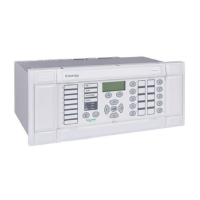P54x/EN AP/La4 Application Notes
(AP) 6-18
MiCOM P543, P544, P545 & P546
AP
2.3.8 Quadrilateral ground resistive reaches and tilting (Distance option only)
Note: Because the fault current for a ground fault may be limited by tower
footing resistance, high soil resistivity, and weak infeeding; any arcing
resistance is often higher than for a corresponding phase fault at the
same location. It maybe necessary to set the RG ground resistive
settings to be higher than the RPh phase setting (i.e. boosted higher
than the rule of thumb in the last subsection). A setting of RG three
times that of RPh is not uncommon.
The P54x allows two different methods of tilting the top reactance line:
Automatic adjustment of the top reactance line angle
Fix setting of the top line that will over-ride dynamic tilting
Both methods are detailed in the Operation chapter.
Dynamic tilting:
Medium/ Long lines:
In the case of medium and long line applications where Quad distance ground characteristic
is used, the recommended setting is ‘Dynamic tilt’ enabled at starting tilt angle of -3° (as per
default settings). The -3° is set to compensate for possible CT/VT and line data errors.
For high resistive faults during power exporting
, the under-reaching zone 1 is only allowed to
tilt down by the angle difference between the faulted phase and negative sequence current
(Iph-I2) starting from the –3° set angle. This ensures stability of zone 1 for high resistance
faults beyond the zone 1 reach even during heavy load conditions (high load angle between
two voltage sources) and sufficient sensitivity for high resistance internal faults. The tilt angle
for all other zones (that are by nature over-reaching zones) will remain at -3 deg.
In the case of power importing, zone 1 will remain at –3° whilst all other zones will be
allowed to tilt up by the
(Iph-I2) angle difference, starting from –3°. This will increase the
zone 2 and zone 4 resistive reaches and secure correct operation in POR and blocking type
schemes.
Short lines:
For very short lines, typically below 10 Miles (16 km), the ratio of resistive to reactance reach
setting (R/X) could easily exceed 10. For such applications the geometrical shape of the
Quad characteristic could be such that the top reactance line is close or even crosses the
resistive axis as presented in Figure 4
Figure 4 Example of high resistive zone 1 fault that falls outside zone 1
characteristic when the starting tilt angle of -3° is set (over-tilting effect).
(Distance option only)

